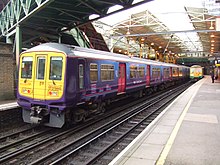Dual electrification

Dual electrificationis a system whereby arailwayline is supplied power both viaoverhead catenaryand athird rail.This is done to enable trains that use either system of power to share the same railway line, for example in the case of mainline and suburban trains (as used atHamburgS-Bahnbetween 1940 and 1955).[1]
Examples
[edit]Germany
[edit]- Line S3 of theHamburg S-Bahnchangeover atNeugraben.
- Birkenwerder stationto be used byBerlin S-Bahnlines S1 and S8 (third rail) and regional train RB20 (overhead lines)
Greece
[edit]- Line 3ofAthens Metrouses third rail for underground part and overhead power supply on surface for access to/fromAirport.
Norway
[edit]- betweenJar stationandBekkestua station,wheremetro line 3andtram line 13share tracks
United Kingdom
[edit]- North London Linechangeover atActon Central,London.
- Northern City Linechangeover atDrayton Park,London.
- Thameslink routechangeover atCity Thameslink(northbound) andFarringdon(southbound), London.
- West London linechangeover betweenWillesden JunctionandShepherd's Bush,London.
- High Speed 1changeover at platforms 5 and 6 ofEbbsfleet International,Kent.
United States
[edit]- South ofPelham station(New York), whereNew Haven Line'sM8'schange from 3rd rail to catenary (northbound) and vice versa (southbound).
- Pennsylvania Station (New York City)
- East River TunnelsbetweenQueensandManhattaninNew York City,NY
- North River TunnelsbetweenWeehawken,NJ and New York City, NY
- Like Athens, the MBTABlue Line(Boston) uses third rail for the underground part, and switches to overhead catenary power atAirport station.
Mainland China
[edit]Variations
[edit]Both systems live
[edit]The system is usually used only in exceptional cases as it can lead to problems caused by the interaction of the electric circuits; for example, where one system is powered withdirect currentand another byalternating current(AC), premagnetisation of the substation transformers of the AC system can occur.
One system live
[edit]A similar arrangement to dual electrification is one in which both means of powering atrainare present, but not live simultaneously. Such arrangements can be found in frontier stations and in sections of railway used for running tests.
See also
[edit]References
[edit]- ^"Archived copy"(PDF).Archived fromthe original(PDF)on 2017-08-08.Retrieved2017-08-08.
{{cite web}}:CS1 maint: archived copy as title (link)
